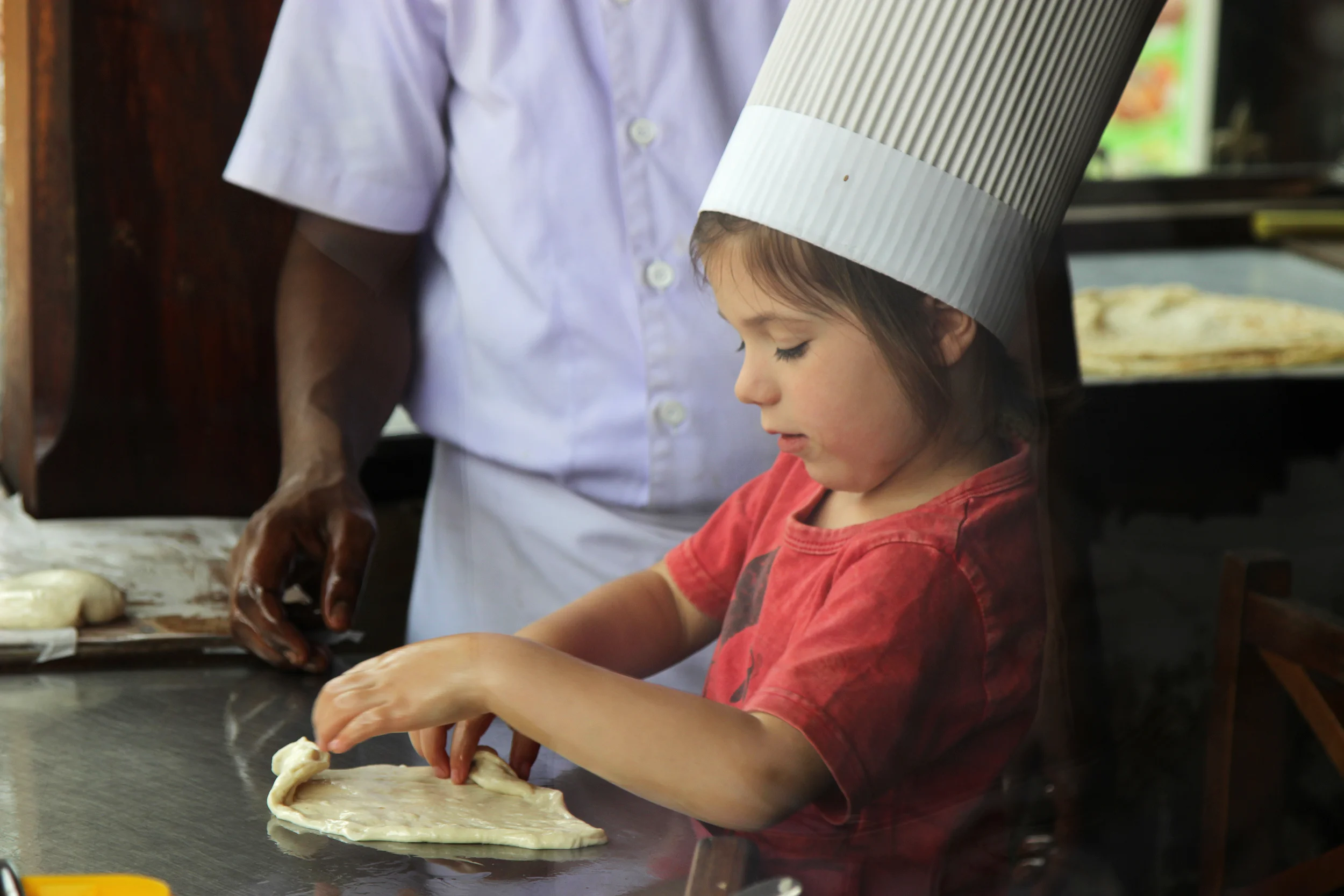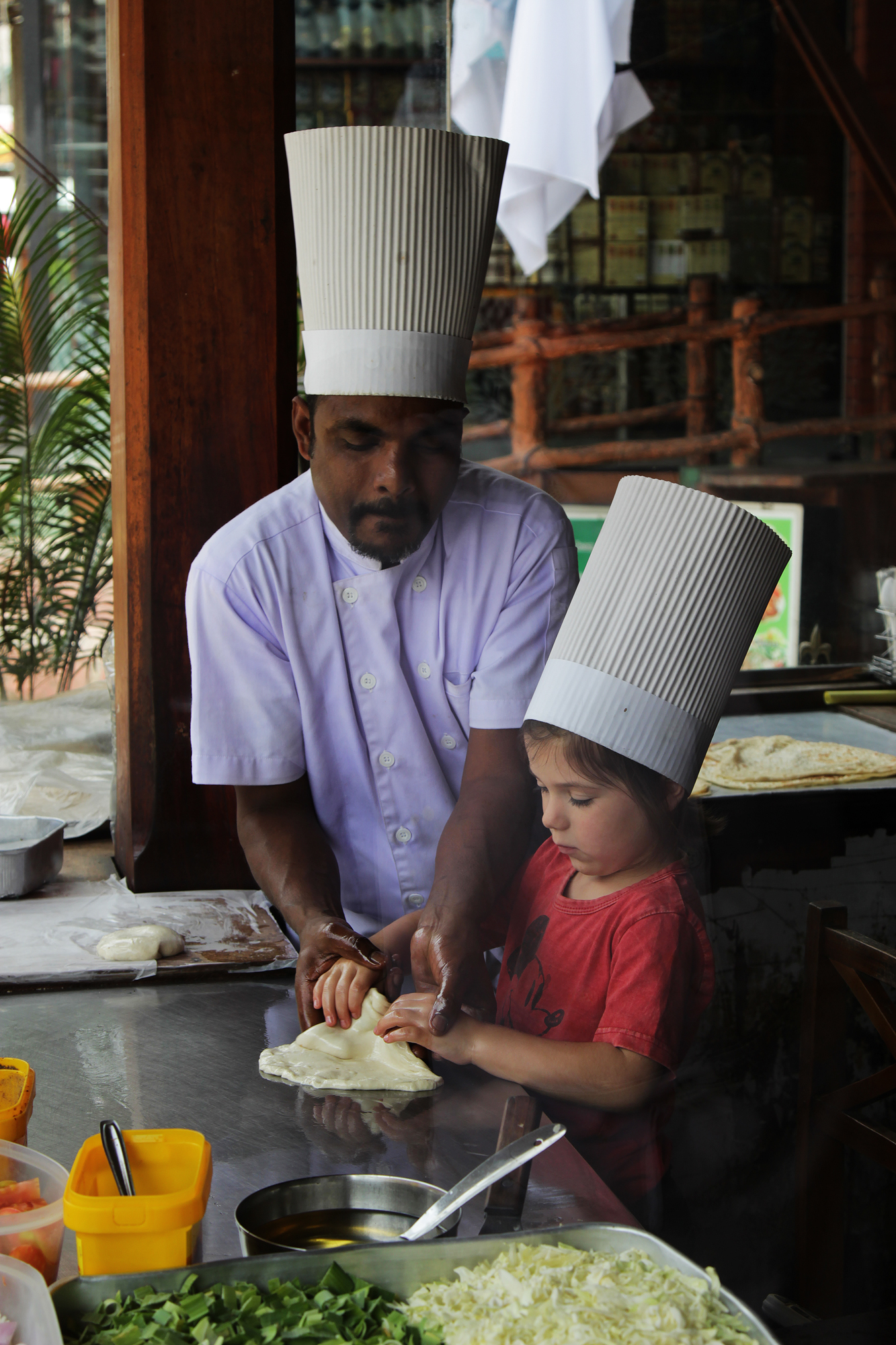Roti school

It’s a drizzly morning in Ella, deep in Sri Lankan hill country, as many October mornings are. But our tummies are calling for food and our brains are calling for stimulation, so we’ve organised a cooking lesson of sorts. I say “of sorts” because the Downtown Rotti Hut doesn’t officially do classes. They do, however, do the food that Olivia loves most in Sri Lanka, so we’ve convinced the manager to give us some time in the kitchen to learn the ropes with his chef.
Roti are a staple of Sri Lankan street food. A meal in a handful, they’re portable and cheaper than chips. They’re flexible too, the crisp doughy wrappings acting as a blank canvas for any number of delicious fillings, from a simple egg for the fusspots to chicken curries with firepower for the brave. We thought making them would be a straightforward process, but that turns out to be far from the truth.
Lori dons a camera and a sleeping River in a sling, while Olivia and I don chef hats and make our way into the glass cube of a kitchen looking out onto Ella’s main road.
The dough itself is simple enough, a mixture of flour, margarine or butter, a little sugar, a pinch of salt and an egg. Then water is added until a smooth, elastic texture is achieved. The whole lot is rolled into balls and laid side by side in a tray. Unlike many breads, this one is fast. Half an hour’s resting time and you’re good to go.
The next bit is a different story. Niroshon, the assistant manager, explains that it’s incredibly difficult to find a great roti chef: there is no school for it. Instead, this ‘training’ takes place over years: it’s a skill taught by loved ones rather than teachers, and it starts in the home. It may be passed down from father to son, or friend to friend. And, as we soon found out, it takes a hell of a lot of practice to get it right.
Here’s the theory. You take a ball of dough and lubricate it with a few drops of vegetable oil. Start to flatten it out with the heel of your hand and then, in one quick motion, flip it up and around on itself. It should (should) land back on the same side, but thinner. Keep going until the dough is paper thin, translucent and ready to cook.
Our attempts are wonky but passable, Olivia’s actually far better than mine. The chef, Selvakumar, shows us how to flip them onto the hot plate (though at home, a roaring frying pan would work just as well), and we watch as the pale dough turns golden and crisps up, bubbles blistering away in the heat.
And that’s it. From there, the customisation begins. You can top, dip or stuff a roti with anything you like. We may have developed a minor addiction to the Curd Shop’s avocado, onion and lime version during our time in Ella, but today, Olivia eats hers with cheese melted onto it before folding, while I dunk my lopsided attempt into a delicate, mild tomato curry, fragrant with coconut cream, onion, curry leaves, turmeric and a touch of chilli powder.
This is fast food, but it’s also good food. And, as Niroshon explains, roti is what Sri Lankan kids always ask for. They may not always get it, as it isn’t always the healthiest of options. But we think this traditional flatbread is a perfect starting point, a simple dough that costs pennies and can be filled with anything from chocolate to salads. The process is entertaining enough to distract children away from their fear of green things or spice. After all, one major thing we’re learning on this journey is that if you make food fun enough, they might just eat it. And if they can make it themselves, even better. So clear the worktop, grab your kids, get messy. And good luck.
Recipe
Downtown's roti
Serves about a million hungry people, but the cooked roti are freezable. And a ready stash of these can only be a good thing.
Ingredients
- plain flour 5kg
- margarine or butter 250g
- an egg
- sugar a tablespoon
- salt a pinch to taste
- water
Method
Use a dough hook attachment to mix together all the ingredients apart from the water, until it comes together in a dough. Add the water drop by drop until the dough becomes elastic, pliable and smooth.
Roll into rounds the size of cricket balls, then rest in a lined tray covered in cling film for half an hour.
After resting, take a ball of dough and lubricate with a few drops of vegetable oil. Using the heel of your hand, flatten the dough out into a rough circle on your worktop. Then, using your forefinger and thumb to hold the edge of the circle, flip it up and around on itself, so that it lands back on the same side. This is almost impossible to describe in words, so Youtube is your friend here.
Cook the roti on a searing hot dry pan for a minute or so on each side, until the surface is golden and blistered.
Serve with any filling you can imagine and kitchen towels, plenty of them.




















